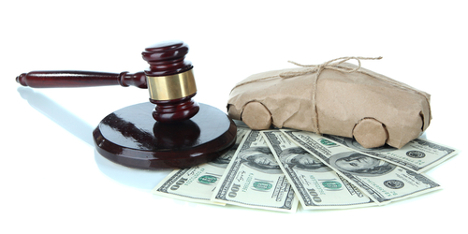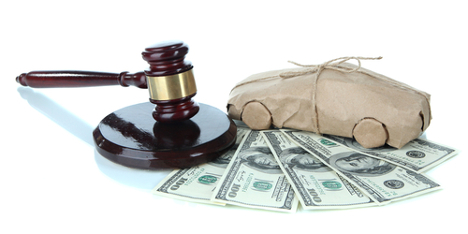Cox Automotive chief economist Tom Webb explained why February’s wholesale price data reinforced a possible market moniker — stability.
Manheim reported on Tuesday that wholesale used-vehicle prices (on a mix-, mileage-, and seasonally adjusted basis) fell by 0.2 percent in February. However, Webb pointed out that given a sharp decline in pricing in February of last year, the Manheim Used Vehicle Value Index showed a year-over-year gain of 1.1 percent as the index reading stood at 124.6 for February.
“Although wholesale prices rose in only one month out of the last seven, stability remains the watchword for used-vehicle values given that all of the declines were small,” Webb said in his commentary that accompanied the latest index update.
“In the face of heavy new-vehicle inventory and incentives, the stability of used vehicle values is a credit to the retail market that continues to provide dealers the ability to quickly retail wholesale acquisitions at reasonable grosses,” he continued.
Webb’s observer colleagues from Cox Automotive — Kelley Blue Book’s Alec Gutierrez and Autotrader’s Michelle Krebs — as well as Jessica Caldwell from Edmunds — recently discussed the new-vehicle market’s impact on potential used-vehicle sales performance, too. This Auto Remarketing report highlighted how those analysts noted challenges franchised dealerships face in finding buyers for their new models — which in some cases are taking the amount of days to turn not seen in almost eight years.
Pricing trends by market class
Price declines and rises split evenly within the six vehicle segments Manheim tracks for its monthly update, again showing the cut between cars and trucks.
Each of the three segments to post price gains in February were in the truck category as prices for pickups rose 6.5 percent, prices for vans climbed 4.9 percent and prices for SUVs and CUVs moved 2.0 percent higher.
Conversely, prices in the three car segments all softened in February, led by luxury cars (down 2.2 percent) and closely followed by midsize cars (down 2.1 percent) and compacts (down 1.6 percent).
“Although it remains the case that pricing for trucks, CUVs, and vans remains up year-over-year while cars are down, the weakest of the car segments (compacts) has actually tracked the overall market the past three months,” Webb said. “It is risky to say that compacts reached their bottom because there have been so many false bottoms over the past couple of years, but there are promising signs.
“On a non-seasonally adjusted basis, sports cars were the only segment that was up, but the February lift was much less than normally occurs,” he continued. “As such, the seasonally adjusted price for sports cars in February was down more than any other major segment. This might have been one area where reduced tax refunds did have an impact.”
Rental market update
Manheim reported that the volume of rental-risk units actually sold grew during the first two months of 2017, even though conversion rates were a “little weak,” according to Webb.
“Given that new-vehicle sales into rental were down during this period, it suggests that the rental companies were getting their fleets right-sized,” he added.
Manheim indicated a straight average of auction pricing for rental risk units in February generated a 5-percent lift from a year ago.
“But much of that reflects mix shifts and mileage changes as well as a temporary weakness in the market last year,” Webb said.
“Our index of rental risk pricing that adjusts for broad changes in mix and mileage was down both sequentially (1.2 percent) and year-over-year (3.8 percent),” he continued.
Manheim went on to mention the average mileage on rental risk units sold at auction was 39,100 miles, “which is very close to what it has averaged since the summer of last year,” Webb said.
It’s been about two weeks since the Internal Revenue Service started to release refunds, and the impact appears to be making its way to the auction lanes.
The latest Black Book Market Insights report indicated small cars and crossovers performing better than luxury vehicles in the car segment. But overall, editors noticed vehicles in the truck segment are still retaining their values better with three segments increasing their value as much as 0.42 percent.
“Small cars and crossovers performed the best among all segments last week, driven by higher interest from tax season buyers,” said Anil Goyal, Black Book’s senior vice president of automotive valuation and analytics.
When reviewing volume-weighted data, Black Book reported overall car segment values decreased by 0.54 percent last week, higher than the depreciation rate of 0.37 percent seen in the previous four weeks.
Editors found that prestige luxury car, luxury car and near luxury car segments declined the most by 0.91 percent, 0.80 percent and 0.56 percent, respectively.
Again looking at volume-weighted information, Black Book determined overall truck segment values — including pickups, SUVs and vans — dropped by 0.48 percent last week, higher than the depreciation rate of 0.28 percent spotted during the previous four weeks.
Editors said minivan, compact luxury crossover/SUV and full-size van segments declined the most by 0.72 percent, 0.69 percent and 0.63 percent, respectively.
Turning next to what Black Book representatives noticed when walking the lanes at about 60 auctions last week, they reported back more sentiments about tax season.
Down in South Carolina, the watcher reported, “Good day at the auction with plenty of consignment and good attendance. Sales were still a bit slow, but tax-time cars were selling well.”
In nearby Tennessee, a similar story played out as Black Book’s representative said, “Sunny and slow today. Retail market isn’t as good as some would like, but it is picking up.”
The pace of sales was modest in a couple of other locations, too. Black Book’s lane observer in Florida said, “There were a lot of vehicles and buyers here today, but sales were not strong.” And up in Illinois, the report was, “Vehicle sales today were around 50 percent with what sold bringing good money. Higher-mile, full-size sport utilities did not sell well today.”
The remaining two Black Book auction observations offered some clarity about what other units are bringing out the auctioneer’s hammer.
In Ohio, “Cloudy today but over positive sentiment towards the market. Sedans, SUVs and trucks all selling well here.” And from California, “Interesting array of vehicles here today, many luxury brands across to hybrid models.”
KAR Auction Services chief economist Tom Kontos looked at January wholesale data and declared that prices “held up surprisingly well.”
According to ADESA Analytical Services’ monthly analysis of wholesale used-vehicle prices by vehicle model class, wholesale used vehicle prices in January averaged $10,945 — up 2.8 percent compared to December and up 6.7 percent relative to January of last year.
ADESA indicated all model classes showed month-over-month and year-over-year price gains except full-size SUV/CUVs, whose prices declined relative to December but were up year-on-year.
“Considering the increased supply of used vehicles wholesaled in January, used vehicle prices held up surprisingly well, despite soft retail demand and high new-vehicle incentives,” Kontos said in his monthly Kontos Kommentary released on Monday. “Nevertheless, pockets of supply-driven weakness did appear in rental program and risk units, and younger vehicles in general.
“The extreme year-over-year gain in minivan prices was driven by a change in mix favoring younger, pricier minivans, which exaggerated the increase,” he added in the video that can be seen here as well as at the top of this page.
ADESA reported average wholesale prices for used vehicles remarketed by manufacturers softened by 3.4 percent month-over-month and 1.4 percent year-over-year.
Analysts pointed out that January prices for fleet/lease consignors were up 4.9 percent sequentially and up 5.1 percent annually.
“Within this segment, however, rental risk units showed year-on-year price declines,” Kontos said.
ADESA also mentioned average prices for dealer consignors in January ticked up 2.5 percent versus December and 3.1 percent relative to last January
Kontos closed by noting that according to National Automobile Dealers Association data, both franchised and independent dealers saw month-over-month decreases in retail used vehicle sales of more than 25 percent, but registered increases versus prior-year. The gain for franchised stores was 4.0 percent and for independent lots, it was 8.1 percent.
He added that January certified pre-owned sales dropped by 17.1 percent month-over-month but edged 0.8 percent higher year-over-year, according to figures from Autodata Corp.
ADESA Wholesale Used-Vehicle Price Trends
| |
Average |
Price |
($/Unit) |
Latest |
Month Versus |
| |
Jan. 2017 |
Dec. 2016 |
Jan. 2016 |
Prior Month |
Prior Year |
| |
|
|
|
|
|
| Total All Vehicles |
$10,945 |
$10,674 |
$10,254 |
2.8% |
6.7% |
| |
|
|
|
|
|
| Total Cars |
$8,867 |
$8,576 |
$8,535 |
3.4% |
3.9% |
| Compact Car |
$6,639 |
$6,413 |
$6,531 |
3.5% |
1.6% |
| Midsize Car |
$8,044 |
$7,773 |
$7,742 |
3.5% |
3.9% |
| Full-size Car |
$8,300 |
$7,971 |
$7,485 |
4.1% |
10.9% |
| Luxury Car |
$13,472 |
$13,049 |
$12,858 |
3.2% |
4.8% |
| Sporty Car |
$13,041 |
$12,748 |
$12,730 |
2.3% |
2.4% |
| |
|
|
|
|
|
| Total Trucks |
$12,990 |
$12,645 |
$12,093 |
2.7% |
7.4% |
| Minivan |
$9,289 |
$8,897 |
$7,141 |
4.4% |
30.1% |
| Full-size Van |
$12,430 |
$11,317 |
$12,120 |
9.8% |
2.6% |
| Compact SUV/CUV |
$10,762 |
$10,481 |
$10,568 |
2.7% |
1.8% |
| Midsize SUV/CUV |
$11,854 |
$11,336 |
$10,758 |
4.6% |
10.2% |
| Full-size SUV/CUV |
$13,715 |
$14,379 |
$12,265 |
-4.6% |
11.8% |
| Luxury SUV/CUV |
$18,697 |
$18,141 |
$17,923 |
3.1% |
4.3% |
| Compact Pickup |
$8,954 |
$8,757 |
$8,268 |
2.2% |
8.3% |
| Full-size Pickup |
$16,039 |
$15,624 |
$15,209 |
2.7% |
5.5% |
Source: ADESA Analytical Services.
Black Book on Monday released its latest joint depreciation report with Fitch Ratings; an analysis that projected 2017 vehicle depreciation to reach 17.8 percent based on estimated new-model sales of 17.0 million.
That forecast is slightly up from the 17.3-percent mark recorded in 2016.
The firms point out that average pre-recession annual depreciation trended between 16 percent and 18 percent.
Between 2011 and 2015, Black Book recounted that average annual depreciation fell between 8.3 percent and 13.2 percent, driven mostly by high demand for used vehicles followed by low supply levels of in-demand segments such as trucks, crossovers and sport utility vehicles. Editors contend much of the pent-up demand fueling both new- and used-vehicle sales has been spent, resulting in a rising level of vehicle depreciation expected in 2017.
What’s more, a continued increase in lease activity along with higher incentives that began in 2016 spell more pressure on residual values, which are also expected to continue falling in 2017, according to the report.
Black Book Used Vehicle Retention Index dropped 6 percent in 2016
Editors explained the Black Book Used Vehicle Retention Index is designed to provide an accurate view of the strength of used vehicle wholesale market values. The index is calculated using Black Book’s published wholesale average value on 2- to 6- year old used vehicles, as percent of original typically-equipped MSRP.
Black Book’s wholesale average is a benchmark value for used vehicles selling in the wholesale auctions with the vehicle quality in average condition. The index is weighted based on registration volume and adjusted for seasonality, vehicle age, mileage, condition, segment mix and inflation.
As more 2- to 6-year-old vehicles return to the market in the coming years, this index is designed to provide an overall measurement of strength and weakness in wholesale used vehicle value retention.
Black Book said the index lost 6 percent in 2016 and is expected to continue its slow decline in 2017 as the used-vehicle market loses strength.
Residual values to decline
Black Book predicted a continual and gradual decline in residuals in the coming years. Currently, editors noted a 3-year-old vehicle is averaging 52 percent of its original typically-equipped MSRP, and this reading is expected to decline to 48 percent by 2020.
Black Book is expecting the market to reach a gradual normalization over the next three years. The company’s biggest concerns include:
—Continuously increasing lease penetration leading to residual losses on the returns due to excess supply
—Higher levels of incentives on new vehicles pushing down used values
—Longer installment contract terms leading to sustained negative equity
“As we continue to move into the New Year, several positive trends that drove market strength will continue to turn and reshape the landscape for used vehicles,” said Anil Goyal, senior vice president of automotive valuation and analytics at Black Book. “Increased supplies from trade-ins and lease returns, coupled with a plateau in new sales activity will bring changes that can affect inventory strategies and profit potential.”
No major concerns for U.S. auto loan ABS
Fitch is expecting prime auto loan asset-backed securities annualized loss rates to move up to the 1.0 percent late in the year, but remain well within historical levels despite these negative trends. The historical average for the index is 0.91 percent going back to 2000, so current levels reported so far in 2017 (as the December 2016 reading was 0.73 percent) are comfortably tracking within Fitch’s expectations.
Subprime auto ABS performance is pressured this year due to softer performance in the 2013 through 2015 vintage securitizations, which have weaker credit quality pools. Fitch’s outlook for subprime asset performance is weakening/stable for 2017.
“Fitch continues to have a positive rating outlook for prime auto loan asset-backed securities (ABS) in 2017, despite higher losses expected this year,” said Hylton Heard, senior director at Fitch Ratings. “Auto ABS asset performance will continue to slow in 2017 as losses slowly rise to normalized levels similar to 2004 through 2006.
“Additionally, depreciation rates will creep up and recovery rates dip which will drive loss severity and contribute to rising losses,” Heard continued.
“Our subprime annualized net loss index is predicted to range between 10 percent and 12 percent during 2017, and could rise to peak levels recorded back in 2008-2009 of approximately 13 percent were the pace of losses to pick up beyond expectations,” he went on to say.
Through January, the subprime annualized net loss index stood at 10.30 percent.
Report availability
The Black Book-Fitch vehicle depreciation report is a joint venture by the two companies utilizing Black Book’s used vehicle depreciation data, and Fitch’s U.S. auto ABS indices data.
Black Book tracks used-vehicle market depreciation rates providing an understanding of how vehicle prices impact automobile lenders and lessors, auto ABS transactions, consumers and other auto market constituents.
The Black Book-Fitch Vehicle Depreciation Report is available for download by going here.
With dealers noticing tax-refund money slowly starting to impact their retail business, Black Book’s latest Market Insights report showed truck segments retaining their value much better than car segments compared with previous weeks.
Editors noticed two vehicle segments within the truck segment — subcompact crossovers and compact vans — maintained their values from the previous week.
Looking at volume-weighted data, Black Book determined overall car segment values decreased by 0.46 percent last week, higher than the depreciation rate of 0.35 percent seen in the previous four weeks.
Midsize car, prestige luxury car and premium sporty car segments declined the most by 0.82 percent, 0.58 percent and 0.58 percent, respectively.
Again reviewing volume-weighted information, editors also found that overall truck segment values — including pickup, SUVs and vans — softened by by 0.27 percent last week, lower than the depreciation rate of 0.34 percent seen in the previous four weeks.
Full-size crossover/SUV and full-size pickup segments dropped the most by 0.44 percent and 0.38 percent, respectively.
“The market sentiment in auction lanes remains optimistic. Luxury vehicles are showing higher depreciation than mainstream brands,” said Anil Goyal, Black Book’s senior vice president of automotive valuation and analytics.
That market sentiment also was confirmed by Black Book editors and other auction observers mingling with dealers in the lanes last week.
In North Carolina, personnel reported back to Black Book saying, “Cheaper units selling very well here with tax money slowly coming in.” And in Indiana, the story was, “Rainy day here today but cars were selling well and everyone seems very positive about the market.”
Out West, the recap was similar with the watcher noting, “Dealer optimism remains high. Midsize and compacts sold well today but luxury units were weak.”
Staying in the region, another editor conveyed observations that supported Black Book’s value trends, mentioning, “Prices stable in this market location with trucks leading demand.”
The other two lane observations coming back to Black Book also originated the South as in Tennessee it was, “Good market here with midsize cars in demand but more no-sales than last week.” And from neighboring Kentucky, “Good crowd here today with a very active Internet. Vehicles sold well most all day with more ‘if-sales’ coming along towards the end.”
As the upbeat atmosphere in the lanes continued, two trends caught the attention of Black Book editors last week.
The latest Black Book Market Insights report indicated luxury segments are seeing increased depreciation so far in 2017, and compact cars are feeling the run-up to the spring selling season with stronger-than-average retention since the beginning of the year.
“All luxury segment accumulative depreciation rates for the first six weeks of 2017 are larger than that of their respective segment averages,” said Anil Goyal, senior vice president of automotive valuation and analytics at Black Book.
Looking at volume-weighted data, editors determined overall car values decreased by 0.22 percent last week. That’s the best weekly retention rate since May of last year. They added all but two car segments had better week-to-week depreciation rates.
In car segments, Black Book noticed prestige luxury, luxury, near luxury and full-size segments declined the most, dropping by 0.69 percent, 0.42 percent, 0.35 percent and 0.26 percent, respectively.
Again examining volume-weighted information, editors computed that overall truck values decreased by 0.36 percent last week. At this time last year, they said the average depreciation rate was 0.14 percent.
As what as the buzz in the lanes, Black Book’s personnel reported plenty of positive news from dealer, especially out West. In Nevada, the lane watcher said, “Healthy market here with several dealers announcing records retail sales for January.”
In Tennessee, dealers are making final preparations to have the inventory they need when shoppers arrive with funds from the IRS as the observer said, “Good market trend here with buyers stocking up for tax time.”
In neighboring Georgia, a similar refrain played out as Black Book’s auction visitor said, “Dealers were willing to step up and pay today for the ones they really needed.”
Staying in the South, Black Book’s representative in North Carolina offered more insight into what dealers wanted coming down the lanes, saying “Good auction today with most buyers looking for that $10,000 or less price range.”
And finally in Pennsylvania, it was the case where Black Book noticed, “Good weather with normal consignment at this location made pretty much an average sale day.”
According to Black Book data, the average price of a used vehicle for model years 2011 through 2015 depreciated by 1.5 percent in January.
Editors determined cars posted an overall depreciation rate of 1.8 percent, while depreciation for trucks produced a rate of 1.4 percent.
Black Book calculated that all vehicles are averaging a 12-month depreciation change of 17.5 percent.
In January, editors noticed premium sporty cars and prestige luxury cars saw the largest drop in value at 2.8 percent.
Vehicles in the premium sports car category include the Chevrolet Corvette, Porsche 911, BMW 6-Series, Mercedes Benz SL-Class, Lexus RC 350 and Audi R8.
Vehicles in this segment finished January with an average segment price of $39,501, a 19.7-percent downturn from year-ago levels ($49,199).
Units in the prestige luxury car segment include the BMW 7-Series, Mercedes Benz S-Class, Lexus LS 460, Audi A8 and Porsche Panamera. This segment ended January with an average price of $35,654, a 25.4-percent decrease from a year ago during the same month.
Black Book pointed out three segments saw a monthly depreciation of only 1.1 percent, boasting the best retention rates for the month of January. Those segments were full-size crossover/SUV, full-size pickups and small pickups.
Editors said small pickups retained their values the best out of all vehicle segment since last year. The segment finished the month of January with a value of $18,734, a 7.9-percent decrease from last year’s value of $20,346. Vehicles in this segment include Toyota Tacoma, Nissan Frontier, Chevrolet Colorado, GMC Canyon and Honda Ridgeline.
“Vehicle retention values remained relatively strong in January heading into the spring selling season," said Anil Goyal, Black Book senior vice president of automotive valuation and analytics. “It is interesting that luxury vehicles are showing higher depreciation than mainstream brand vehicles across vehicle segments.”
Along with its monthly update on the specialty market, the latest Black Book Market Insights report showed both car and truck segments retaining their values better than they have in the past nine months.
Editors determined subcompact cars, compact cars, compact crossover/SUVs and compact vans preformed the best, depreciating just 0.06 percent or less.
“Good sales and optimism from auction buyers reported across the country. Both car segments and light truck segments showed good retention in values with depreciation levels lowest in nine months,” said Anil Goyal, Black Book’s senior vice president of automotive valuation and analytics.
Volume-weighted, Black Book reported on Tuesday that overall car values decreased by 0.35 percent last week. This reading is better than the average depreciation rate of 0.43 percent seen in the previous four weeks.
In car segments, editors noticed the premium sporty car, prestige luxury car, sporty car and near luxury car segments declined the most, dropping by 0.75 percent, 0.59 percent, 0.56 percent and 0.54 percent, respectively.
Against looking at the volume-weighted figures, Black Book said overall truck values decreased by 0.20 percent last week. This level is better than the average depreciation rate of 0.42 percent spotted during the previous four weeks.
In truck segments, editors determined sub-compact crossover, full-size van, full-size crossover/SUV and midsize luxury crossover/SUV segments softened the most, declining by 0.70 percent, 0.55 percent, 0.49 percent and 0.48 percent, respectively.
The latest recap from Black Book’s observers in the lane summarized that a general upbeat vibe is emanating from dealers.
In Ohio, Black Book representative said, “Stable market here with sedans, SUVs and trucks all in demand,” while in neighboring Pennsylvania, the auction watcher added, “Above normal amount of buyers here this week which is very positive for this time of year.”
Further south in Tennessee, a similar refrain appeared as “Above normal amount of consignment and attendance both contributed today to a good amount of sales.”
Out West, Black Book’s personnel in Washington said, “Prices continue to be stable with normal amount of sales and good positive attitudes at this location.” And in Nevada, it was the case where, “Great sale with lots of optimism from buyers and sellers alike. Midsize and compacts cars both sold well today.”
The closest account to a negative observation came from Texas where Black Book’s lane watcher noted, “Nice weather today with normal amount of dealers but still many no-sales.”
Black Book’s specialty report
Editors also offered their assessment of the five segments of the specialty market they track. The rundown is as follows:
— Collectibles: “If the January auctions are any indication, and they usually are, 2017 is going to be a very good year for collectible vehicles,” Black Book said. Editors indicated that Mecum’s Kissimmee, Fla., sale, followed closely by Barrett-Jackson, Russo and Steele, RM Sotheby’s, Bonhams, Gooding, Worldwide, and Silver in the Scottsdale, Ariz., area, were very well attended, both in person and electronically via television and the Internet.
— Recreational Vehicles: “Just when you think the markets have stabilized and settled into long established seasonal patterns, they do something to surprise you,” editors said. Black Book indicated both motorized and towable units shook off their recent losses and posted “impressive” gains for the month.
— Powersports: Black Book acknowledged the powersports market is off to a slow start this year as auction activity and pricing, which usually begin to pick up steam sometime between December and January, have remained relatively flat so far this year.
— Heavy-Duty Trucks: With less than half the volume in January than spotted at auction in December, “it seems for the moment that demand has lined up with supply resulting in very little late model depreciation for month one of 2017,” editors said.
— Medium-Duty Trucks: Black Book reported that medium-duty segments dropped a bit more in January compared to the previous four months. This past month, editors calculated that the 2006 through 2013 models depreciated an average of $278 or 1.50 percent. They added the 2014 and 2015 models dropped an average of $498 or 1.2 percent.
Cox Automotive chief economist Tom Webb tipped his cap, so to speak, with regard to dealers being able to turn used metal after reviewing how wholesale prices behaved during the opening month of the year.
Manheim reported on Tuesday that wholesale used-vehicle prices (on a mix-, mileage-, and seasonally adjusted basis) slipped slightly in January. That movement brought the Manheim Used Vehicle Value Index to 124.8, a decline of 0.3 percent from a year ago.
“The theme that played throughout 2016 continued into the start of 2017 as wholesale pricing remained stable despite sharply rising supplies,” Webb said in his commentary that accompanied the latest index reading. “Give credit to a retail used-vehicle market that enabled dealers to quickly and profitably sell their auction purchases.”
Webb offered more evidence as to why dealers kept deliveries going.
“After rising by 14.5 million over the past six years, total U.S. employment grew by another 227,000 in January,” Webb said.
“Although January wage growth was a disappointment and the number of people employed part time for economic reasons rose, the stability of the labor market, as represented by a low level of involuntary layoffs and a high level of job openings per job seeker, suggests that consumers will be willing to take on more used-vehicle loans and that lenders will be willing to lend,” he went on to say.
More details about price movements
On a year-over-year basis, Webb pointed out that 2017 started the same as all of 2016 with truck prices moving up and car prices softening.
Manheim reported the upward movement of truck and van prices were the most dramatic of the six categories analysts watch. Truck prices climbed 5.2 percent while van prices rose by 4.3 percent.
And as Webb referenced, prices for compacts and midsize cars softened again in January as Manheim pinpointed the drop-offs at 3.9 percent and 2.6 percent, respectively.
The other two vehicle segments including the monthly update changed little last month as Manheim indicated prices for luxury cars ticked 0.8 percent lower and prices for SUVs/CUVs edged just 0.1 percent higher.
“A cursory look at wholesale pricing by price tier and market segment suggests only a modest impact from the delayed flow of tax refunds this year,” Webb said. “That stands in contrast to the many electronic and furniture retailers who reported that late January sales were negatively affected by the reduced monies.”
How off-rental segment performed
Manheim determined that rental risk prices remained off by 4 percent from a year ago.
In January, analysts also found that rental-risk prices (adjusted for broad shifts in mix and mileage) were flat relative to December. Last month, Manheim also noticed small and midsize crossovers accounted for 26.4 percent of all rental risk units sold at auction, up from 21.5 percent a year ago. Meanwhile, small and midsize cars accounted for 45.9 percent of rental risk auction sales this year versus 51.7 percent last year.
Webb mentioned that new-vehicle sales into rental declined by approximately 7 percent in January relative to last year’s “heavily front-loaded purchasing pattern.
“Strong auction volumes in January thus suggest that rental fleet sizes were reduced,” he added.
Reviewing retail sales landscape
Along with that mention of new-vehicle sales into rental fleets, Webb delved deeper into how dealers are moving both new and used vehicles.
“Total used-vehicle sales for January have yet to be released; but channel checks suggest a small single-digit increase year over year,” Webb said, adding that certified pre-owned sales rose a “modest” 0.8 percent as a result of declining CPO car sales by domestic brands “with weak potential margins the likely headwind.”
Webb then noted, “Nevertheless, CPO sales continued to rise faster than new vehicle sales, just as they have done for a little over four years now.”
Based on CarMax results for the segment of its fiscal year from September to November and both AutoNation and Group 1 Automotive results for the fourth quarter, Webb projected that it is likely that the seven publicly traded dealership groups will achieve a gain in same-store used retail unit sales for the 29th time out of the past 30 quarters.
“For some players, gross margins showed signs of stabilizing and turn rates remained good even with a lower wholesaling percentage,” Webb said. “That backdrop suggests a continuing healthy appetite for the growing number of units coming off lease.”
Meanwhile, Webb sees the latest new-vehicle sales performance sending a mixed message.
Webb recapped that new cars and light-duty trucks sold at a seasonally adjusted annual rate (SAAR) of 17.5 million in January. This compares to a pace of 18 million in the fourth quarter and full-year total of 17.5 million for last year.
“After such a strong December, most analysts had expected a larger pullback in January. Incentives, however, continued to play an outsized role; up 15 percent year-over year, according to Autodata,” Webb said. “Somewhat offsetting that were reduced fleet sales and higher transaction prices as a result of both model mix shifts and higher trim levels.
“The coming impact of new-vehicle inventory overhang is also less than clear,” he continued. “The top-line days’ supply numbers were scary, but less so after accounting for seasonal issues, model shifts, temporary factors, and reduced fleet volumes. Still, production cuts seem warranted.”
Black Book found that both its vehicle value data and mood in the lanes reflected an upbeat direction as the industry approaches spring activities.
This week’s Black Book Market Insights report again showed compact cars demonstrating better retention heading into the early spring selling season.
Editors mentioned the overall truck segment values decreased by only 0.27 percent last week. However, they also spotted that full-size crossovers/SUVs posted a weekly depreciation rate of 0.51 percent.
“Market sentiment in the auction lanes is optimistic with good sales reported last week. Demand is picking up as dealers stock up for the tax refund buyers,” said Anil Goyal, Black Book’s senior vice president of automotive valuation and analytics.
Volume-weighted, Black Book indicated overall car segment values decreased by 0.46 percent last week, slightly higher than the depreciation rate of 0.42 percent seen in the previous four weeks.
Editors found that prices in prestige luxury car and luxury car segments declined the most by 1.57 percent and 0.86 percent, respectively.
Volume-weighted, Black Book determined values in the overall truck segment (including pickup, SUVs and vans) decreased by 0.27 percent last week; lower than the depreciation rate of 0.42 percent noted in the previous four weeks.
Editors added the full-size crossover/SUV and midsize crossover/SUV segments declined the most by 0.51 percent and 0.40 percent, respectively.
Turning next to Black Book’s auction observers, separate reports out of Pennsylvania headlined the positive mood.
“Good sale today. Dealers were upbeat and buying inventory,” the first recap from the Keystone State said. While the other added, “Market here is booming with trucks and SUVs in the most demand.”
In Tennessee, Black Book’s lane representative using the same adjective, saying, “Good stable market here with tax time cars being in largest demand.”
Further south in Florida, auction watchers reported, “Dealers looking for clean older cars for tax season. Trucks sold well as usual but so did smaller cars.”
The positive vibe extended out West as the report from Nevada noted, “The lanes are full of post-holiday optimism with SUV’s leading demand.”
The only negative recap came from Michigan where Black Book’s watcher said, “Very cold today reducing attendance somewhat. Buyers only purchasing what they needed but nothing extra.”












